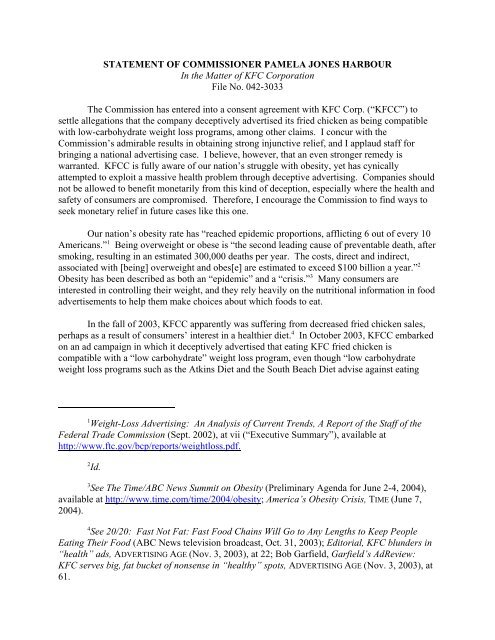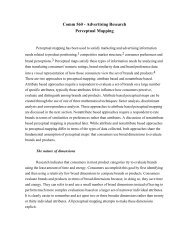KFC - Decision
KFC - Decision
KFC - Decision
You also want an ePaper? Increase the reach of your titles
YUMPU automatically turns print PDFs into web optimized ePapers that Google loves.
STATEMENT OF COMMISSIONER PAMELA JONES HARBOURIn the Matter of <strong>KFC</strong> CorporationFile No. 042-3033The Commission has entered into a consent agreement with <strong>KFC</strong> Corp. (“<strong>KFC</strong>C”) tosettle allegations that the company deceptively advertised its fried chicken as being compatiblewith low-carbohydrate weight loss programs, among other claims. I concur with theCommission’s admirable results in obtaining strong injunctive relief, and I applaud staff forbringing a national advertising case. I believe, however, that an even stronger remedy iswarranted. <strong>KFC</strong>C is fully aware of our nation’s struggle with obesity, yet has cynicallyattempted to exploit a massive health problem through deceptive advertising. Companies shouldnot be allowed to benefit monetarily from this kind of deception, especially where the health andsafety of consumers are compromised. Therefore, I encourage the Commission to find ways toseek monetary relief in future cases like this one.Our nation’s obesity rate has “reached epidemic proportions, afflicting 6 out of every 10Americans.” 1 Being overweight or obese is “the second leading cause of preventable death, aftersmoking, resulting in an estimated 300,000 deaths per year. The costs, direct and indirect,associated with [being] overweight and obes[e] are estimated to exceed $100 billion a year.” 2Obesity has been described as both an “epidemic” and a “crisis.” 3 Many consumers areinterested in controlling their weight, and they rely heavily on the nutritional information in foodadvertisements to help them make choices about which foods to eat.In the fall of 2003, <strong>KFC</strong>C apparently was suffering from decreased fried chicken sales,perhaps as a result of consumers’ interest in a healthier diet. 4 In October 2003, <strong>KFC</strong>C embarkedon an ad campaign in which it deceptively advertised that eating <strong>KFC</strong> fried chicken iscompatible with a “low carbohydrate” weight loss program, even though “low carbohydrateweight loss programs such as the Atkins Diet and the South Beach Diet advise against eating1Weight-Loss Advertising: An Analysis of Current Trends, A Report of the Staff of theFederal Trade Commission (Sept. 2002), at vii (“Executive Summary”), available athttp://www.ftc.gov/bcp/reports/weightloss.pdf.2Id.3 See The Time/ABC News Summit on Obesity (Preliminary Agenda for June 2-4, 2004),available at http://www.time.com/time/2004/obesity; America’s Obesity Crisis, TIME (June 7,2004).4See 20/20: Fast Not Fat: Fast Food Chains Will Go to Any Lengths to Keep PeopleEating Their Food (ABC News television broadcast, Oct. 31, 2003); Editorial, <strong>KFC</strong> blunders in“health” ads, ADVERTISING AGE (Nov. 3, 2003), at 22; Bob Garfield, Garfield’s AdReview:<strong>KFC</strong> serves big, fat bucket of nonsense in “healthy” spots, ADVERTISING AGE (Nov. 3, 2003), at61.
eaded, fried foods.” 5 In another ad, <strong>KFC</strong>C advertised that eating two of its “Original Recipe”fried chicken breasts was better for a consumer’s health than eating a Burger King Whopper –even though the chicken is nearly equivalent to the Whopper in fat grams and is actually higherin trans fat, cholesterol, sodium and calories. 6 Both ads also promote an entire bucket ofchicken, even though the voiceovers in the ads referenced one or two-piece servings. 7<strong>KFC</strong>C knew (or certainly should have known) that its ads were false and deceptive, andthat the ads would encourage consumers to believe that <strong>KFC</strong> fried chicken was much healthierfor them that it actually is. Only a few days after the ads aired, an Advertising Age editorialstrongly criticized <strong>KFC</strong>C for running them, describing the ads as “desperate and sleazy tactics.” 8In an interview on National Public Radio, the executive editor of Advertising Age stated that itwas “very unusual” for the publication to run such a staff editorial, but justified it by saying that“[i]nstead of being truth well told, which is what advertising should be, it seems like not only anexaggerated claim, but basically an effort to deceive.” 9 Consumer advocacy groups complainedabout the ads as well, and the ads were the subject of much discussion until they stopped airingin late November 2003. 10I have voted to accept the proposed settlement because it contains very strong injunctiverelief that will go a long way toward preventing <strong>KFC</strong>C from engaging in similar deceptiveadvertising in the future. In addition to addressing the specific claims made in the <strong>KFC</strong>C ads,the proposed consent agreement also contains more general language prohibiting <strong>KFC</strong>C frommaking representations about the absolute or comparative amount of fat, cholesterol, sodium,calories, or any other nutrient in any food it sells that contains chicken; about the compatibilityof such food with any weight loss program; or about the health benefits of such food, unless the2004).5In the Matter of <strong>KFC</strong> Corporation, File No. 042-3033, Complaint at 5, 8-9 (June 2,6 Id. at 7 (“While compared to Burger King's Whopper, two <strong>KFC</strong> Original Recipe friedchicken breasts have slightly less total fat (38 g. v. 43 g.) and saturated fat (12 g. v. 13 g.), theyhave more trans fat (3.5 g. vs. 1 g.), more cholesterol (290 mg. v. 85 mg.), more sodium (2300mg. vs. 980 mg.), and more calories (760 v. 710).”).7See, e.g., World News Tonight with Peter Jennings: Good for You? <strong>KFC</strong> Adverts (ABCtelevision broadcast, Nov. 19, 2003); NBC Nightly News with Tom Brokaw: Federal TradeCommission Wanting Proof That <strong>KFC</strong>’s Chicken Can Be Called a Health Food in TVCommercials (NBC television broadcast, Nov.18, 2003); <strong>KFC</strong> Corporation, Complaint at 5(setting forth voiceovers).8 Garfield, supra note 4.9 Day To Day: Jonah Bloom Discusses Advertising Age Magazine’s Editorial Criticismof <strong>KFC</strong>’s New Ad Campaign (National Public Radio broadcast, Nov. 6, 2003).10See, e.g., Bruce Schreiner, <strong>KFC</strong> Ends Healthy Fried Chicken Ad Blitz, ASSOC. PRESSONLINE (Nov. 19, 2003); 20/20, supra note 4.
epresentation is true and, at the time it is made, <strong>KFC</strong>C possesses and relies upon competent andreliable evidence – which in certain specified cases must be competent and reliable scientificevidence – that substantiates the representation. 11Accepting injunctive relief alone is reasonably consistent with the Commission’s priorsettlements in similar cases. However, where a company appears to have exploited a nationalhealth crisis, an even stronger response from the Commission is warranted. While I recognizethat it may be difficult to calculate monetary relief in these kinds of cases, I would like to see theCommission develop methodological approaches that would support seeking such remedies infuture cases of similar types of deceptive advertising, as the Commission has done in the past.For example, in 1995, the FTC settled charges with The Dannon Company that it had made falseor misleading claims for its Pure Indulgence line of frozen yogurt. As part of the consentagreement, Dannon agreed to pay $150,000 in disgorgement. 12 Similarly, in 1983, the FTCsettled charges with Estee Corporation that it had misled consumers by falsely claiming that thesweeteners in its foods had been accepted by the American Diabetes Association and the Foodand Drug Administration. Estee Corporation agreed to pay $25,000 in cy pres relief to theAmerican Diabetes Association or the Juvenile Diabetes Foundation. 13While injunctive relief is important in deceptive advertising cases such as this one,monetary relief may further serve to correct unlawful conduct, reverse its ill effects, and deterfuture violations of the law. Well-formulated cy pres relief, in particular, may provide realbenefits to consumers. It is not only reasonably related to the violation, but also reasonablylikely to reach the individuals most injured by a particular deceptive advertisement. Should theappropriate case present itself in the future, I strongly encourage the Commission to consider theapplicability and effectiveness of cy pres and other potential monetary remedies.11 In the Matter of <strong>KFC</strong> Corporation, File No. 042-3033, Analysis of Proposed ConsentOrder to Aid Public Comment (June 2, 2004).12 FTC Press Release, Dannon Agrees To Settle FTC Charges That Low-Fat Ad Claimsfor Frozen Yogurt were False and Misleading (Nov. 25, 1995); In the Matter of The DannonCompany, Inc., Dkt. No. C-3643, 121 F.T.C. 136, 139 (March 18, 1996) (consent order).13In the Matter of Estee Corporation, Dkt. No. C-3126, 102 F.T.C. 1804, 1812 (Nov. 16,1983) (consent order). Cy pres relief, also known as indirect restitution or fluid recovery, is usedin situations where injured persons cannot be directly compensated. Instead, under cy pres,restitutionary funds are awarded in some alternate way that indirectly benefits the injuredpersons.




